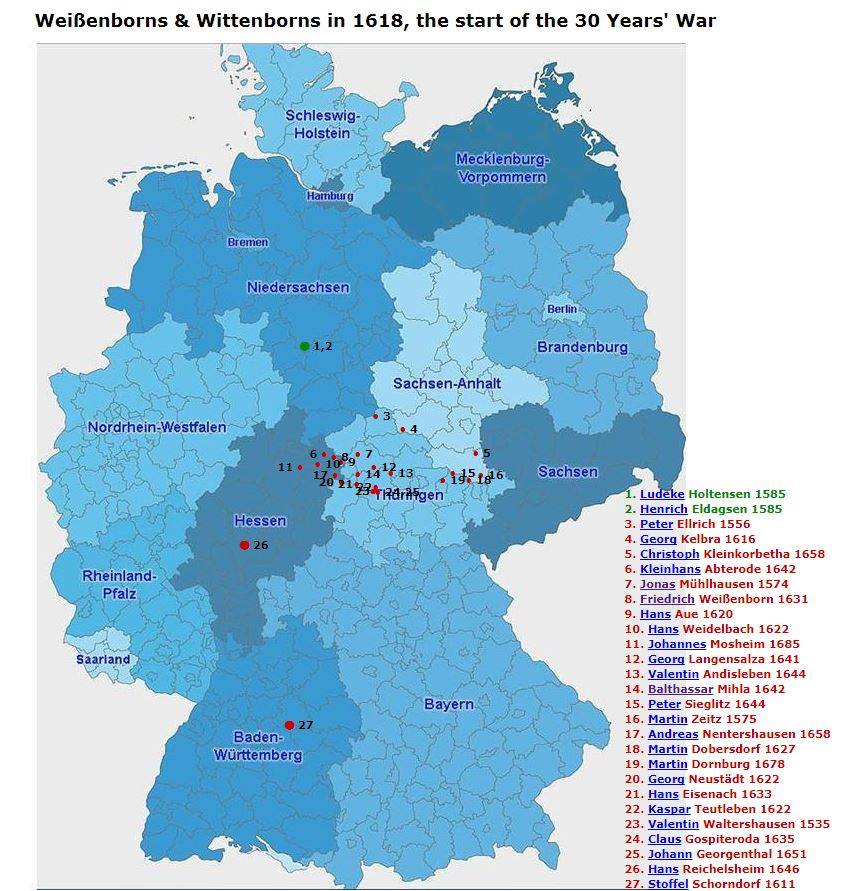41. Reporting on my June 2017 search for Weis(s)enborns: Saturday 24 June.
Posted on Facebook on 20 July 2017. I broke up my tent and left the busy campsite - the evening before a large group had arrived - with a light heart. The Freibad in Mihla had been a pleasant home for a second time, and probably there will be a third time. I drove to Weißenborn near Eschwege. In view of the clustering of Weißenborns in 1618 - see the attached map - I use as working hypothesis that this is the village from which many present-day Weißenborns have got their family name. In 2015 the 650th anniversary of Weißenborn was celebrated. This is the anniversary of the first time the village was mentioned in an official document. The village therefore already existed in the time that family names were adopted, namely between 1200 and 1350. I now regretted that my camera had stopped working on Wednesday, as there was much to see in the village. Weißenborn is located on the flank of a hill, with road L3300 on the lower side and the stout church with its roof of grey slates in the middle of the village, see attached picture. The 8 minute video made by the tourist information reflects rather well what I have seen. There is a museum in Weißenborn with remnants and memories of its history. Unfortunately it was closed on Saturday. On many street corners, old pictures taken from that location were displayed in durable material, with information on the history of the houses and its owners. I then drove via Eschwege to the little village of Ermschwerd near Witzenhausen, to have a first impression of the village and its church. I have a lead that in 1690 my ancestors - and hence those of many Wittenborns and Weisenborns - have moved from this area to Veckerhagen, which was my next destination. After pitching up my tent I drove to the church in Veckerhagen. I had a similar experience as 25 years ago: when I felt whether the church door was open, I had already been seen. A voice from far behind me asked if I was interested in seeing the interior. When I looked around, I only saw a lady with a child in a buggy talking to a middle-aged man. They didn't take notice of me. I waited patiently. After more than a minute the man and lady said good-bye and he walked over to me. Jens Gerth had the key ready and showed me around in the church which has been renovated in 2007. He somewhat casually said that the pewter baptism font and the accompanying ewer for holding the water to be used for baptism had been obtained from the church in the neighbouring village Vaake. He showed that on the bottom of both it was engraved that they had been given to the community of Veckerhagen in 1680 by a noble lady. My earliest known ancestor Zacharias Wittenborn had married Gertrud Wentzel from Vaake in this church on 4 February 1692. Subsequently his eleven children were baptised there, most likely all with this font and ewer. Even though nothing actually happened, history came alive for me when I saw this font and ewer 300 years later. While I was spending my time until 3 pm reading outside restaurant "Schnitzel Schmiede", I heard behind me a young couple trying to order in English. I turned around as I heard the waitress say "no English" and I helped out. The couple, Sarah and Or, invited me to join them. When we came to speak about ancestry, Or showed me the DNA determination made by 23andmy. I gradually understood that as Ashkenazic Jew he had no other way of finding relatives. Many of his and Sarah's family members had been murdered in WWII, and their surviving relatives refused to speak about ancestry. What a different situation they are in compared to me! I intend to bring to bear DNA analysis to resolve how many independent families have as first ancestor someone who adopted the name Weißenborn between 1200 and 1350. At 3 pm I met with village historian and church council member Thomas Ende. He lives with his wife Andrea in the same house as 25 year ago, having bought it after both parents had died. We compared views on many issues of genealogical interest. One particular issue was of great interest to me: what could have made the two brothers Zacharias and Hans George Wittenborn, both shepherds, leave their parental village in 1690 and come to live in Veckerhagen and Hemeln, on both side of the river Weser? Thomas pointed out that several offices in the villages of those days were filled by appointing people. Shepherds who tend the villages' herds and millers who man the villages' water and wheat mills were amongst them. I may hence go by the working hypothesis that the brothers were members of a large family and looked for vacancies in the profession they were familiar with. It then makes sense that they have stayed as close to their parental village as possible. Hence Zacharias' mother was able to come over to Veckerhagen for a baptism in 1699. Whence she came the register doesn't say. To be figured out. When I left at 5, Thomas expressed the wish that I wouldn't let another 25 years go by before visiting him again. I replied that I hoped it wouldn't be 25 years before I could take my grandchildren to Veckerhagen and show them what they can still find of their 17th and 18th century Weißenborn roots.

